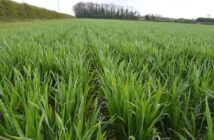The most effective elimination of black-grass and rye-grass immediately ahead of crop emergence is crucial in taking full advantage of the golden opportunity delayed wheat drilling offers in managing these troublesome grass weeds.
But this isn’t always easy to achieve with spraying and drilling days as limited as they can be on heavy ground after mid-October, not to mention lower temperatures and less rapid weed growth limiting herbicide uptake and translocation.
“Drilling in the second half of October has the great advantage of ensuring the majority of the season’s black-grass and ryegrass emerges before the crop,” noted Roundup technical manager, Barrie Hunt. “Colder weather can also mean better persistence of key residuals for longer-lasting control of later-emerging weed seedlings.
“However, more challenging weather and growing conditions make it important to do everything you can to achieve the best activity from your pre-planting glyphosate; especially so, if it’s the only spray you’ve applied since your immediate post-harvest work as you’ll have more than two months of weed growth to deal with.
“Less-than-ideal pre-planting control of troublesome annual weeds ahead of drilling is something you simply cannot afford these days,” he stressed. “Quite apart from wasting time and money and putting extra pressure on hard-pressed pre-and post-em chemistry, an incomplete kill is the fastest route to resistance development.
“If you’ve got bad black-grass it’s no exaggeration to say that this will be your most important spray of the season. So you’ve got to get it right.”
To do so Barrie Hunt recommends spraying off with modern Roundups formulated for challenging conditions as close to drilling as possible, pointing out that their annual grass weed rainfastness of one hour and a cultivation interval of just six hours provides particularly valuable operational flexibility at this time of the year.
Even though they are proven to give more effective control under challenge conditions than traditional glyphosates, he is adamant that the right rate of the specific Roundup formulation used remains essential.
“You typically need 540 g/ha of glyphosate to control grass weed seedlings of up to six tillers and up to 1800 g/ha for the most difficult perennials,” he pointed out. “It’s also important to appreciate that adjuvants will not make up for any lack of active ingredient.
“Water volumes as low as 100 litres/ha are fine, allowing you to cover the most hectares in a day and get higher concentrations of glyphosate onto the leaf. However, this shouldn’t be a rush job. You’ll get the best coverage with flat fan nozzles operated at around 2.5 bar, a boom height of around 50 cm and forward speed of 12 km/hour, with drift- risk reducing Roundup formulations enabling you to use less coarse sprays for the best targeting of small, thin seedling weed leaves.
“Where drilling has to be delayed for more than a few days after stubble spraying do remember to include a permitted glyphosate with your pre-em to deal with already emerged but often hard-to-spot weed seedlings,” Barrie Hunt suggested. “This is important as residuals applied after drilling won’t deal with the surprisingly large number of seedlings that can emerge in this time under the right conditions.”



